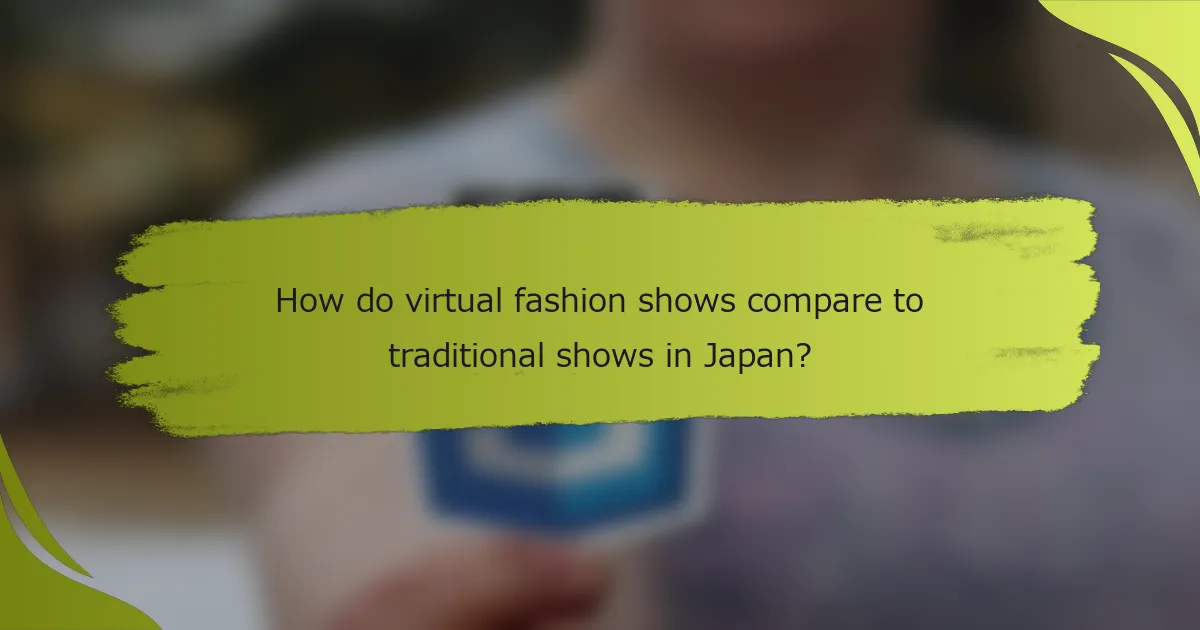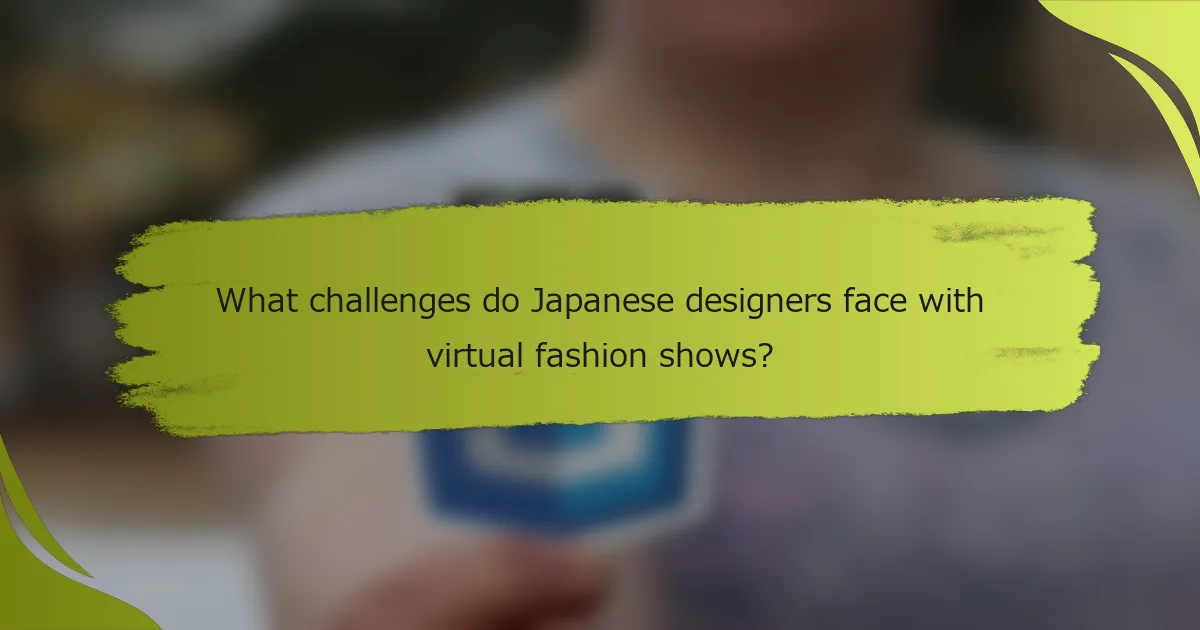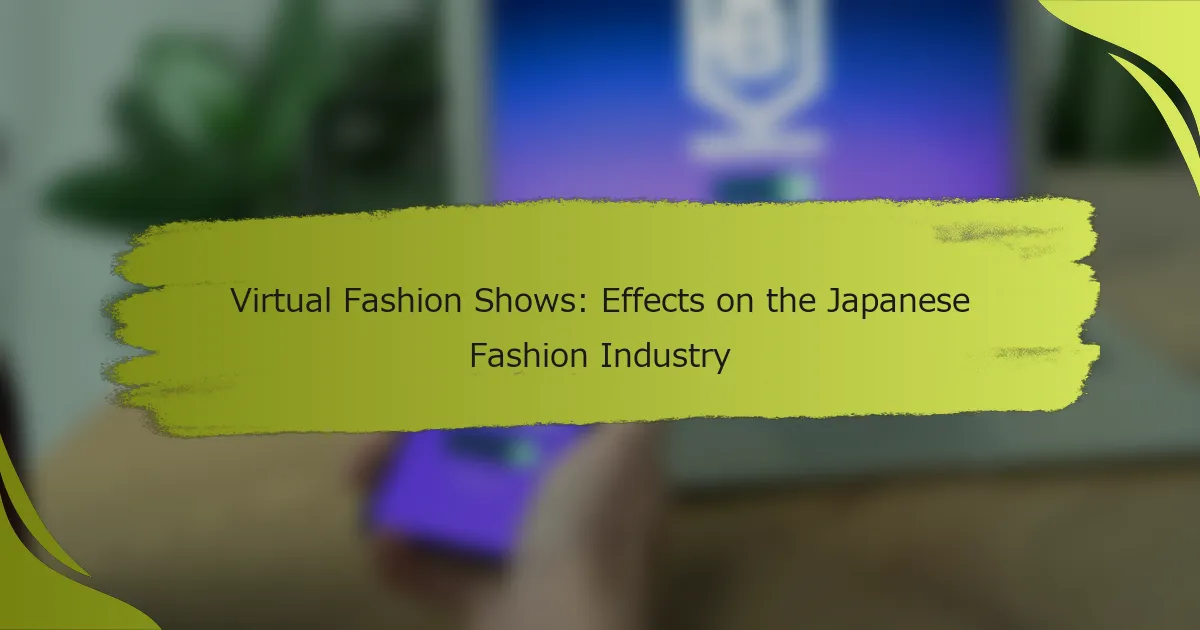バーチャルファッションショーは、日本のファッション業界において、アクセスの拡大とデザイナーの広範なオーディエンスへのアプローチを可能にすることで、重要な変革をもたらしています。これらのデジタルプラットフォームは、物理的な会場の制約を超えてコレクションを披露できるため、従来のファッションマーケティング戦略を変える要因となっています。

How are virtual fashion shows transforming the Japanese fashion industry?
Virtual fashion shows are significantly reshaping the Japanese fashion industry by expanding accessibility and enabling designers to reach a wider audience. These digital platforms allow brands to showcase their collections without the constraints of physical venues, thus altering traditional fashion marketing strategies.
Increased global reach
Virtual fashion shows provide Japanese designers with the opportunity to connect with international audiences, breaking geographical barriers. By broadcasting online, brands can attract viewers from various countries, increasing their visibility and potential customer base.
For instance, a Tokyo-based designer can now showcase their collection to fashion enthusiasts in Europe or North America, which was more challenging with traditional runway shows. This global reach can lead to increased sales and brand recognition beyond Japan.
Enhanced audience engagement
These digital platforms facilitate interactive experiences, allowing audiences to engage with the content in real-time. Viewers can comment, share, and participate in discussions during the show, creating a sense of community around the brand.
Additionally, features like live Q&A sessions or behind-the-scenes content can deepen the connection between designers and their audience. This level of engagement fosters loyalty and encourages potential customers to invest in the brand.
Cost-effective production
Producing a virtual fashion show is often more cost-effective than traditional events, which require significant expenses for venue rental, staffing, and logistics. Brands can allocate resources more efficiently, focusing on high-quality production values without the overhead costs.
For example, a virtual show can be produced with a smaller team and less equipment, yet still deliver a visually stunning experience. This financial flexibility allows emerging designers to participate in fashion showcases that they might not afford otherwise.

What are the key benefits of virtual fashion shows in Japan?
Virtual fashion shows in Japan offer significant advantages, including increased accessibility for designers and immediate viewer feedback. These benefits help brands reach wider audiences and adapt their offerings based on real-time insights.
Broader accessibility for designers
Virtual fashion shows eliminate geographical barriers, allowing designers from various regions of Japan to showcase their collections without the need for physical venues. This inclusivity enables emerging talents to gain visibility alongside established brands.
Additionally, online platforms can host larger audiences than traditional shows, which often have limited seating. This expanded reach can lead to increased sales opportunities and brand recognition.
Real-time feedback from viewers
Virtual formats allow designers to receive immediate reactions from viewers through social media and live chat features. This instant feedback can guide designers in making quick adjustments to their collections or marketing strategies.
Moreover, analyzing viewer engagement metrics, such as likes and shares, provides valuable insights into consumer preferences. This data can inform future designs and promotional efforts, enhancing overall market responsiveness.

How do virtual fashion shows compare to traditional shows in Japan?
Virtual fashion shows offer a unique alternative to traditional shows in Japan by reducing costs and expanding audience reach. While traditional shows are often exclusive events, virtual formats allow for broader participation and accessibility, reshaping how fashion is presented and experienced.
Lower environmental impact
Virtual fashion shows significantly reduce the environmental footprint associated with traditional events. They eliminate the need for extensive travel, large physical venues, and the production of elaborate sets, which can consume substantial resources. This shift aligns with growing sustainability concerns in the Japanese fashion industry.
By minimizing waste and energy consumption, brands can appeal to eco-conscious consumers. For instance, a virtual show might save tens of thousands of kilograms of CO2 emissions compared to a traditional runway event.
Greater flexibility in presentation
Virtual fashion shows provide designers with greater flexibility in how they present their collections. Unlike traditional shows, which are bound by time and space, virtual formats allow for creative storytelling through various multimedia elements. Designers can create immersive experiences that engage viewers in innovative ways.
This flexibility also enables brands to quickly adapt their presentations based on audience feedback or current trends. For example, a collection can be showcased through interactive 3D models or live-streamed events, catering to diverse consumer preferences and enhancing viewer engagement.

What technologies are driving virtual fashion shows in Japan?
Virtual fashion shows in Japan are primarily driven by augmented reality (AR) applications and live streaming platforms. These technologies enable designers to showcase their collections in innovative ways, reaching wider audiences and enhancing viewer engagement.
Augmented reality applications
Augmented reality applications allow users to experience fashion shows in an immersive way by overlaying digital elements onto the real world. For instance, brands can create AR filters that let customers virtually try on clothing or accessories through their smartphones. This interactivity not only enhances the shopping experience but also encourages social sharing.
In Japan, popular AR applications include Snapchat and Instagram filters, which are often used during fashion events to engage audiences. Brands should consider integrating AR features into their marketing strategies to attract tech-savvy consumers and create memorable experiences.
Live streaming platforms
Live streaming platforms are essential for broadcasting virtual fashion shows to global audiences in real-time. Platforms like YouTube, Instagram Live, and Twitch allow designers to reach viewers directly, fostering a sense of immediacy and connection. This approach can significantly increase brand visibility and engagement.
When using live streaming, brands should ensure high-quality video and audio to maintain viewer interest. Additionally, incorporating interactive elements such as live Q&A sessions or polls can enhance viewer participation and make the experience more dynamic. It’s crucial to promote the event in advance to maximize attendance and engagement.

What challenges do Japanese designers face with virtual fashion shows?
Japanese designers encounter several challenges with virtual fashion shows, including technical skill gaps and market saturation. These issues can hinder their ability to effectively showcase their collections and connect with audiences.
Technical skill gaps
Many Japanese designers lack the necessary technical skills to create engaging virtual fashion shows. This includes proficiency in digital design tools, 3D modeling software, and video production techniques. Without these skills, designers may struggle to present their work in a visually appealing manner.
To bridge this gap, designers can consider collaborating with tech-savvy professionals or taking online courses focused on digital fashion presentation. Investing time in learning these skills can significantly enhance the quality of their virtual shows.
Market saturation
The rise of virtual fashion shows has led to increased competition, resulting in market saturation. With numerous brands and designers showcasing their collections online, it becomes challenging for individual designers to stand out. This oversupply can dilute audience attention and engagement.
To combat saturation, Japanese designers should focus on unique storytelling and brand identity in their presentations. Highlighting cultural elements or innovative design concepts can help capture audience interest and differentiate their offerings in a crowded market.

How can Japanese brands leverage virtual fashion shows for lead generation?
Japanese brands can effectively use virtual fashion shows to generate leads by showcasing their collections to a global audience, engaging potential customers through interactive experiences. By integrating digital marketing strategies, they can attract and convert viewers into loyal customers.
Targeted online marketing strategies
To maximize lead generation, Japanese brands should implement targeted online marketing strategies that focus on specific demographics and interests. Utilizing social media platforms like Instagram and TikTok can help reach younger audiences who are more inclined to engage with digital content.
Brands can also leverage data analytics to identify trends and consumer preferences, allowing them to tailor their virtual shows and promotional efforts accordingly. For instance, using retargeting ads can remind viewers of their favorite pieces from the show, encouraging them to make a purchase.
Collaborations with influencers
Collaborating with influencers can significantly enhance the visibility of virtual fashion shows for Japanese brands. Influencers can help promote the event to their followers, creating buzz and attracting a larger audience. Choosing influencers who align with the brand’s values and aesthetics is crucial for authenticity.
Additionally, brands can involve influencers in the virtual show itself, such as having them model pieces or provide commentary. This not only boosts engagement but also establishes a personal connection with potential customers, making them more likely to convert into buyers.
